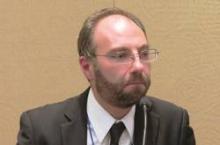BALTIMORE – Serotonin syndrome can easily develop in the intensive care unit, particularly when patients receive opiates and antiemetic medications in addition to the serotonin-enhancing medications they may already be taking.
“These medications are pervasively present, and they are notorious for drug-drug interactions,” Dr. Alejandro Rabinstein said at the annual meeting of the American Neurological Association. “And, in the ICU, we often use them without even realizing it. The combination can be enough to cause serotonin syndrome, which is sometimes recognized too late, and can have serious consequences.”
Because there are scant data on the phenomenon, Dr. Rabinstein, a critical care neurologist at the Mayo Clinic, Rochester, Minn., conducted a literature search to identify cases and examine their outcomes. His series comprised 33 patients, 22 of whom were seen at the Mayo facility. The patients were a median of 42 years old. Four of them had been admitted with serotonin syndrome as their primary diagnosis, but it was either unsuspected or had not yet developed in the remainder.
For 17 patients (52%), the primary reason for admission was a change in mental status or altered consciousness. Four were admitted for sepsis syndrome. Other reasons included resuscitation after cardiac arrest (three), severe pneumonia (two), tumor-related complications (two), emergency surgery (two), graft vs. host disease (one), liver failure (one), and trauma (one).
At admission, the mean APACHE-III score was 67, although the range was wide (11-146). A total of 18 patients required mechanical ventilation, and 6 had undergone surgery before serotonin syndrome developed.
All of the patients showed altered mental status, a key characteristic of serotonin syndrome. Agitation was present in 14 patients. Other common signs were tachypnea (23), tachycardia (20), clonus (29), hyperreflexia (24), and rigidity (26). Mydriasis was present in 14 and tremor in 12. Seven patients were markedly diaphoretic. Fever was present in 14.
About 40% of the group (13 patients) developed signs of serotonin syndrome only after they were hospitalized (mean day 4). Dr. Rabinstein said 22 drugs with a direct serotonin-enhancing action were involved in the cases. In fact, almost all were taking at least one such drug on admission, and 70% got new serotonergic medications while in the ICU.
About 75% of the patients were taking a selective serotonin reuptake inhibitor when admitted (citalopram, fluoxetine, sertraline, escitalopram, and paroxetine ). Almost a third were taking a selective norepinephrine reuptake inhibitor (venlafaxine and duloxetine). About a fourth were taking some other antidepressant with serotonergic activity (trazodone, mirtazapine, buspirone, clomipramine). While in the ICU, three patients received a new serotonergic antidepressant.
Four patients were taking an antiemetic upon admission, and seven started a new antiemetic when admitted. Three were taking an opioid upon admission, and 21 started an opioid when admitted.
All of the patients received benzodiazepine treatment, and 24% had to be paralyzed while their serotonergic symptoms resolved. The anticholinergic antihistamine cyproheptadine was given to the 13 most severely affected patients. However, Dr. Rabinstein said, its efficacy couldn’t be reliably assessed because of this selection bias.
It took a mean of 56 hours for patients to recover to the point where they could interact normally, but the range of recovery time was very wide (8-288 hours). Despite some increases in creatinine kinase and lactic acid, none of the patients developed rhabdomyolysis-related kidney failure. Although serotonin syndrome can be fatal, there were no related deaths in this group.
The review points to how easily ICU treatment can precipitate a very serious neurologic disorder. “Almost everyone came into the ICU on one of these medications, and almost everyone got at least one more after arriving,” Dr. Rabinstein said. “It’s something we have to be on the alert for. The reason I did this study was simply to raise awareness, because this diagnosis is blown all the time. You don’t have to be a neurologist to make this diagnosis, but you need to be very attentive to these signs. ”
He had no financial disclosures.
On Twitter @alz_gal

